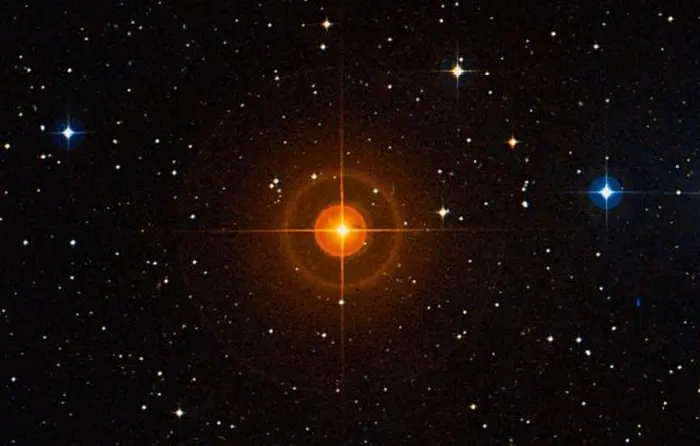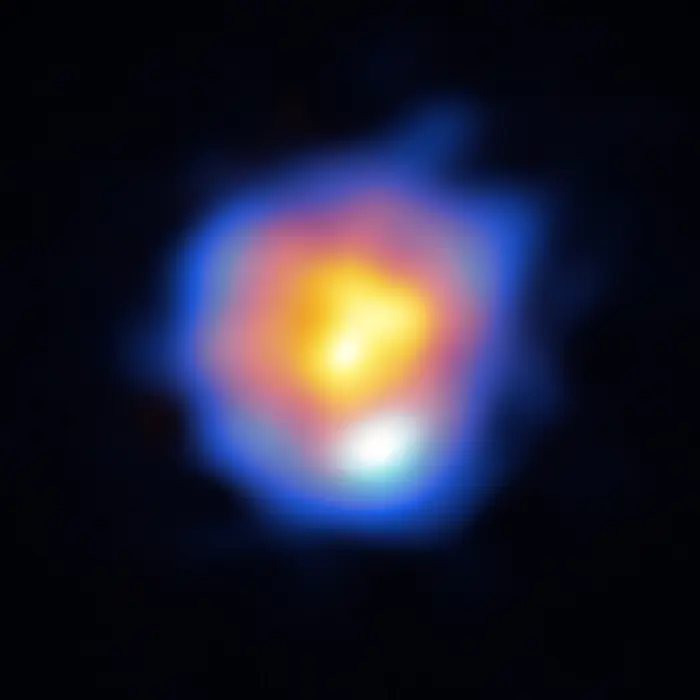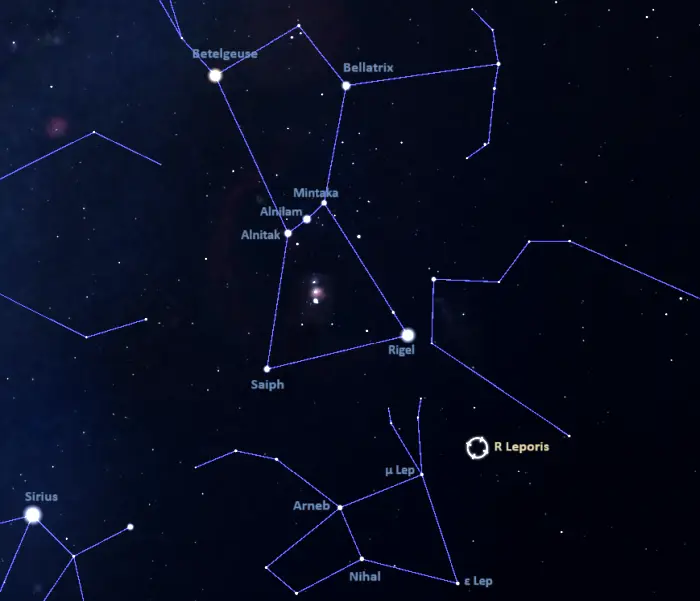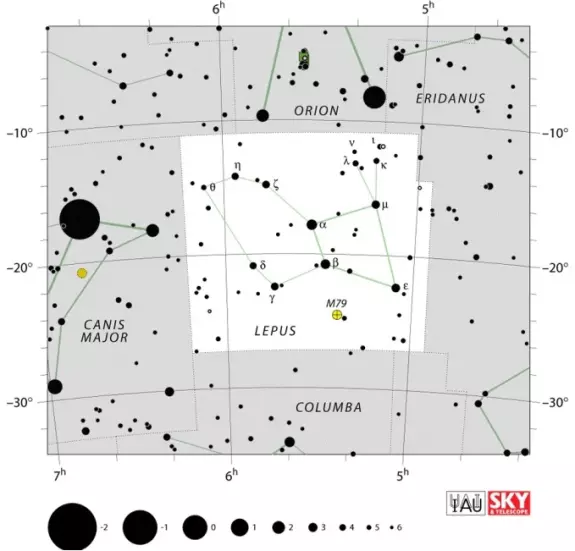Hind’s Crimson Star (R Leporis) is a carbon star located approximately 1,490 light-years away in the southern constellation Lepus (the Hare). It is one of the reddest stars visible to the unaided eye. The star’s brightness varies from magnitude 5.5 to 11.7. At its brightest, R Leporis is visible without binoculars in good conditions.
Star type
R Leporis is a carbon star of the spectral type C7,6e(N6e). It is a cool and evolved giant star on the asymptotic giant branch (AGB) whose atmosphere is composed of more carbon than oxygen. The carbon in the star’s atmosphere is produced by helium fusion near the stellar core and dredged up to the surface.
As carbon and oxygen combine in the star’s upper layers, they form carbon monoxide, which consumes most of the oxygen in the star’s atmosphere. Other carbon compounds that form give the star a distinctly red appearance.
Hind’s Crimson Star has a mass between 1 and 2.02 solar masses and a radius that varies between 645 and 860 solar radii. The star is losing mass through a strong stellar wind and may soon create a planetary nebula.
R Leporis is a long-period Mira variable star whose apparent magnitude varies from 5.5 to 11.7 with a period of 418 – 441 days. Mira variables are pulsating stars that vary in brightness, size and temperature due to the pulsations. They are typically evolved red giants in the last stages of their evolutionary cycle. These stars will soon eject their outer gaseous envelopes to form planetary nebulae, leaving behind hot stellar remnants that will illuminate the clouds of expelled material for about 10,000 years.
More recent studies of the variability of R Leporis have found a period of 427.07 days, which corresponds to a luminosity of 13,200 Suns. Astronomers have also proposed a secondary period of 40 years.
Hind’s Crimson Star appears the reddest every 14.5 months, when it is at its faintest. During this time, the star cannot be seen without binoculars or a telescope.

Hind’s Crimson Star (R Leporis), image credit: ESO/Digitized Sky Survey 2 (CC BY 4.0)
Facts
R Leporis was discovered by the English astronomer John Russell Hind in October 1845. Hind observed the star from the George Bishop Observatory in London. He reported it to be in the constellation Orion and described it as “a drop of blood on a black field.”
The star’s variability was first noted in 1855 by Schmidt, who found a highly irregular period of around 438 days.
R Leporis is one of the few carbon stars that are visible to the unaided eye. Others include TX Piscium in the zodiac constellation Pisces, La Superba (Y Canum Venaticorum) in Canes Venatici, U Hydrae in Hydra, and VY Ursae Majoris in Ursa Major.
Hind’s Crimson Star was imaged by the Atacama Large Millimeter/submillimeter Array (ALMA) in 2023. At the time, this was the highest resolution image ever taken with the interferometer.

This image of R Leporis, a star in the final stages of its evolution, is the highest resolution image ever achieved with ALMA. It has an angular resolution of 5 milli-arcseconds, equivalent to seeing a 10-metre-long bus on the Moon. It was achieved using the ALMA Band 10 (high-frequency) receivers and an array configuration with a maximum baseline length of 16 km, as well as a novel calibration technique. Submillimeter-wave emission from the stellar surface is shown in orange and hydrogen cyanide maser emissions at 891 GHz are shown in blue. The observations show that the star is surrounded by a ring-like structure of gas and that gas from the star is escaping to the surrounding space. Image credit: ALMA (ESO/NAOJ/NRAO)/Y. Asaki et al. (CC BY 4.0)
Name
R Leporis does not have a proper name formally approved by the International Astronomical Union (IAU). It is commonly referred to by its variable star designation R Leporis.
The star is also known as Hind’s Crimson Star. The name comes from its discoverer, the English astronomer John Russell Hind, who described R Lep as “of the most intense crimson.”
Location
R Leporis appears in the region of the sky in front of the celestial Hare’s head, near the border with the constellation Eridanus (the River). It can be found by extending a line from Arneb (Alpha Leporis) through the fainter Mu Leporis and another line from Mintaka in Orion’s Belt through Rigel. R Leporis appears at the intersection of these two lines.
At declination -14° 48’, the star is visible from most locations for at least part of the year.

The location of R Leporis (Hind’s Crimson Star), image: Stellarium
Constellation
Hind’s Crimson Star is located in the constellation Lepus. The celestial Hare is one of the 48 Greek constellations catalogued by Ptolemy of Alexandria in his Almagest in the 2nd century CE. It represents a hare chased by the giant huntsman Orion and his two dogs, Canis Major and Canis Minor.
Lepus is the 51st largest constellation in the sky. It stretches across only 290 square degrees south of the celestial equator. The constellation’s brightest stars – Arneb (Alpha Leporis) and Nihal (Beta Leporis) – shine at third magnitude. Arneb, a massive yellow supergiant, lies 2,200 light-years away, while Nihal, a yellow bright giant, lies 160 light-years away.
Lepus is also home to the orange giants Epsilon and Delta Leporis, the Mira-type variable T Leporis, the pulsating red giant RX Leporis, the blue subgiant Mu Leporis, and the symbiotic binary star SS Leporis.

Lepus constellation map by IAU and Sky&Telescope magazine (Roger Sinnott & Rick Fienberg) (CC BY 3.0)
Notable deep sky objects in the constellation include the bright globular cluster Messier 79 (M79), the planetary nebula IC 418 (the Spirograph Nebula), the barred spiral galaxy NGC 1694, the irregular galaxy NGC 1821, and the lenticular galaxies NGC 1993 and NGC 1979.
The best time of the year to see the stars and deep sky objects in Lepus is during the month of January, when the constellation appears higher above the horizon in the early evening. The entire constellation is visible from locations south of the latitude 63° N.
The 10 brightest stars in Lepus are Arneb (Alpha Lep, mag. 2.589), Nihal (Beta Lep, mag. 2.84), Epsilon Leporis (mag. 3.166), Mu Leporis (mag. 3.259), Zeta Leporis (mag. 3.524), Gamma Leporis (mag. 3.587), Eta Leporis (mag. 3.72), Delta Leporis (mag. 3.85), Lambda Leporis (mag. 4.286), and Kappa Leporis (mag. 4.43).
Hind’s Crimson Star – R Leporis
| Spectral class | C7,6e(N6e) |
| Variable type | Mira variable |
| U-B colour index | +5.74 |
| B-V colour index | +1.47 |
| Apparent magnitude | 5.5 – 11.7 |
| Distance | 1,490 ± 40 light-years (460 ± 10 parsecs) |
| Parallax | 2.1914 ± 0.0602 mas |
| Radial velocity | 32.4 ± 2 km/s |
| Proper motion | RA: 6.679 ± 0.073 mas/yr |
| Dec.: −1.263 ± 0.058 mas/yr | |
| Mass | 1.00 – 2.02 M☉ |
| Luminosity | 13,200 L☉ |
| Radius | 645 – 860 R☉ |
| Temperature | 2,290 K |
| Metallicity | −0.409 dex |
| Surface gravity | −0.6 cgs |
| Constellation | Lepus |
| Right ascension | 04h 59m 36.3486921120s |
| Declination | −14° 48′ 22.502479140″ |
| Names and designations | R Leporis, R Lep, Hind’s Crimson Star, HD 31996, HR 1607, HIP 23203, C* 276, BD−15 915, SAO 150058, GC 6093, GCRV 2957, PPM 215123, IRC -10080, RAFGL 667, CGCS 833, FBS L 9-63, FBS 0457-148, AAVSO 0455-14, GSC 05329-00366, GEN# +1.00031996, JP11 962, IRC -10080, AKARI-IRC-V1 J0459363-144822, ASAS J045936-1448.4, SKY# 7799, RAVE J045936.4-144823, TIC 316971749, ASASSN-V J045936.48-144821.5, UBV M 10532, WEB 4505, WISEA J045936.34-144822.6, IRAS 04573-1452, 2MASS J04593635-1448226, TYC 5329-366-1, Gaia DR2 2987082722815713792, Gaia DR3 2987082722815713792 |